Nearly 17% of U.S. adults experience some degree of hearing difficulty, but many people who could benefit from hearing aids have never used them. (1) In 2022, the FDA approved over-the-counter (OTC) hearing aids, creating a more affordable and accessible alternative to prescription devices. (2)
While research indicates the stigma of wearing hearing aids is reducing, the demand for discreet in-canal hearing aids is growing. (3, 4) According to a recent poll, more than one in three people would try to hide hearing aids if they needed them. (5) Eargo creates small, nearly invisible hearing aids that fit comfortably inside the ear canal. Eargo’s OTC hearing aids are rechargeable and have advanced features like noise reduction. Our team has tested and evaluated multiple Eargo models, with a detailed focus on the Eargo 7, evaluating each one for its ease of use, effectiveness, comfort, and more.
Our favorite Eargo hearing aids
Our pick for the best overall Eargo hearing aid is the Eargo 7. It stands out thanks to its advanced AI-driven sound processing, adaptive noise reduction, and comfortable, nearly invisible design. This hearing aid delivers excellent sound clarity in various environments and is perfect for all-day wear. Read on for full details and testing insights.
Our picks for the best Eargo hearing aids
Compare Eargo hearing aids

|
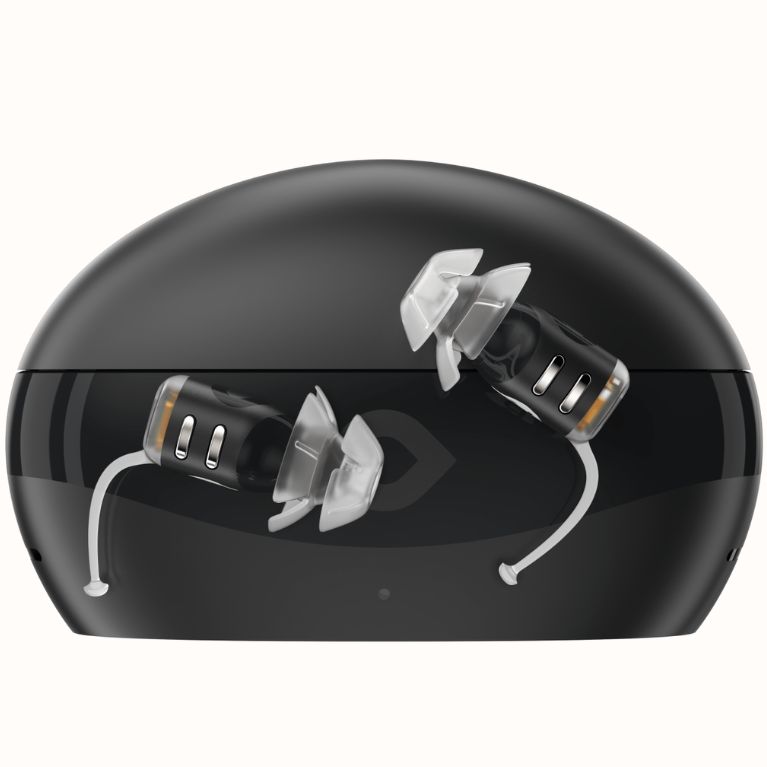
|
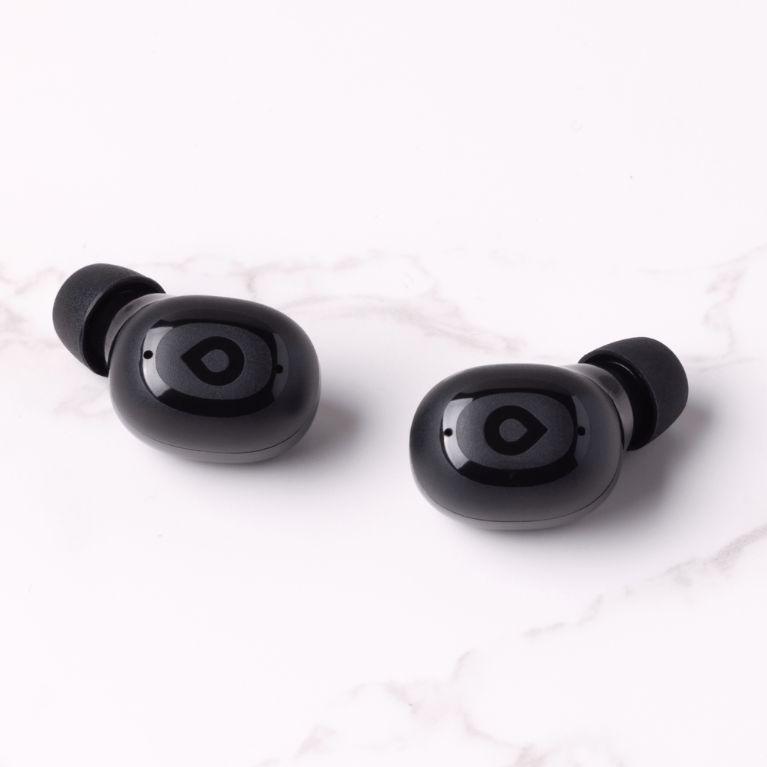
|
|
| Eargo 7 | Eargo SE | Eargo Link | |
| Rating | |||
| Price | $2,950 | $1,650 | $799 |
| Type | OTC | OTC | OTC |
| Style | CIC | CIC | Earbud |
| Battery type | Rechargeable | Rechargeable | Rechargeable |
| App? | Yes | Yes | No |
| Bluetooth streaming | No | No | Yes |
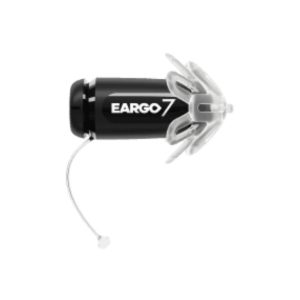

Key product features
What you should know
The Eargo 7 is a small, user-friendly hearing aid. It has advanced features but some limitations.
- Testers say the Eargo 7 provides excellent speech clarity in moderately noisy environments but struggles in very loud settings.
- At $2,950, it’s more expensive than some OTC models, but AI-driven technology and comfortable fit make it a premium option.
- Ideal for those with mild to moderate hearing loss who prioritize discreteness and features like app control.
- Not Bluetooth hearing aids, so the lack of streaming may be a deal-breaker for users who like to connect directly to their phones for media.
- The compact size could be challenging for users with dexterity issues.
Eargo 7 hearing aids overview
The Eargo 7 is an advanced over-the-counter (OTC), completely-in-canal (CIC) hearing aid designed for people with mild to moderate hearing loss. Our testers say features like AI-powered sound adjustment and a discreet design appeal to those who want a simple yet effective hearing solution.
Sound features
The Eargo 7’s standout feature is its Sound Adjust+ technology with Clarity Mode, which uses artificial intelligence to automatically adapt to different listening environments. This tool ensures that conversations remain clear, even in loud spaces, by lowering background noise while boosting speech. This automatic adaptation means you don’t need to make constant manual adjustments, which is beneficial for users with active lifestyles.
Testers used the Eargo 7 in a busy coffee shop and said that speech clarity improved, though the device struggled a bit in very loud environments. While the technology doesn’t include directional microphones, the adaptive features worked well in most daily scenarios.
Setup, app, and tap control
The SoundMatch feature allows users to self-fit their device through the Eargo smartphone app, which connects to the hearing aids via Bluetooth. During the initial setup, the hearing aids must remain in the charger while the app performs updates and customizes the devices based on the user’s hearing needs. Research shows this setup process provides a fit comparable to one in a hearing aid clinic. (6)
The app also allows users to adjust volume and background noise filtering, switch between programs, and check battery levels. While the app controls offer great customization, our testers say the setup process is time-consuming, with updates taking as long as 20 minutes.
Eargo 7 has four preset programs (Normal, Phone, Music, and TV), and users can add up to three more personalized programs through the app. The Eargo 7 sits in the ear canal, and built-in tap control lets users switch between programs by double-tapping their ears. A voice notification tells you which program you’ve selected. We like that this feature makes it easy to change programs without pulling out your phone, but volume adjustments must still be made through the app.
Comfort and fit
Comfort is a major priority with the Eargo 7, which uses soft, flexible silicone petal tips. The hearing aids come with open and closed petal tips in two sizes, and which one you select depends on a number of factors.
Open petals have small openings, allowing more airflow into the ear canal. This reduces the “plugged” feeling that some users experience with in-ear hearing aids. Open petals provide a more natural sound, as they let some ambient noise in the ear, which can be beneficial in quieter environments or when users want to remain aware of their surroundings.
Closed petals create a more sealed fit in the ear, blocking out external noise. This design is useful in busy environments to amplify sound through the hearing aid and reduce background noise. However, some users may find closed petals less comfortable for long periods. We recommend you experiment with both types of petals to find the best fit for you.
The hearing aids also come with a pull tab—a tiny wire extending from the back of the devices— that makes insertion and removal easier. Even so, testers say the small size of the device makes them tricky to handle, especially if you have larger fingers or dexterity issues.
With an IPX7 rating, the Eargo 7 is highly water-resistant and can withstand immersion up to one meter for up to 30 minutes (7). This level of protection makes the devices resistant to splashes, sweat, and accidental submersion, but they are not designed for swimming.
Battery and charger
The battery in these rechargeable hearing aids lasts up to 16 hours, which is enough for a full day of use but slightly shorter than some other options. The Eargo 7’s portable charging case provides two full charges for the hearing aids. The case is compact enough to fit in a pocket, making it convenient for on-the-go use. During testing, the charger and batteries took about four hours to fully charge. While the charger is easy to use, testers say the case’s magnetic port isn’t as strong as that of some competitors like Jabra or Lexie.
What comes in the box
Your Eargo 7 includes everything you need to get started. You’ll receive two hearing aids, a portable charging case, a USB charging cord with an adapter, and both open and closed petal tips to customize your fit. The kit also includes a cleaning brush and microfiber cloth to help with maintenance.
Final thoughts
The Eargo 7 is an excellent choice for people with mild to moderate hearing loss who want a discreet device with features like AI-powered automatic sound adjustment. While it lacks Bluetooth streaming for music or calls, the Eargo 7’s tap control and app-based customization still provide a user-friendly experience. The comfortable fit and advanced sound technology make the Eargo 7 a top-tier OTC hearing aid. However, users who prefer a more traditional behind-the-ear (BTE) hearing aid with longer battery life or simpler controls may prefer another option.
What customers are saying
The Eargo 7 earned a 4.2 out of 5-star rating from an average of nearly 200 Amazon reviews. Customers appreciate the easy-to-use SoundMatch, excellent sound quality, comfortable fit, and simple maintenance.
“One of the features that has really become one of my favorites is the charging case. I can wear the aids ALL day and then place them in the charging case to charge back up. I place the case in my pocket and go to work. Once at work, I can place the hearing aids in my ears and use them that day,” says Robert P. on Amazon. “I truly believe that I hear better with them in. I can sit on the couch and hear the TV with the volume at a non-grandpa level. I say “huh” a lot less, and I can hear most conversations better.”
Some reviewers complain the handling wire detaches from the devices. While this is covered by the warranty, needing to repair your hearing aids is inconvenient. Others complain about a “tinny” sound and discomfort or itchiness from wearing the device fully inside their ear canal, which is a common issue for any CIC hearing aid.
“Tonal quality seems to be good and you just have to experiment in different settings to see how they will work for you. My hearing loss is in the higher frequencies, so at first, everything sounded ‘tinny’ but as time has gone on, the sounds are more ‘normal’ to me now. I just seem to hear better, which is the goal, isn’t it? They are comfortable for me to wear, but I do not like the solid petals. They made my ears itch. The open petals were a much better fit for me,” says Greg R. on Amazon.
We’ve featured Eargo 7 hearing aids in:
- The Best Invisible Hearing Aids
- The Best Over-the-Counter Hearing Aids
- The Best Rechargeable Hearing Aids
- The Best Hearing Aids
Who Eargo 7 hearing aids are recommended for:
- People with mild to moderate hearing loss looking for discreet, nearly invisible hearing aids
- Users who prefer modern features like AI-driven sound adjustment and app-based controls
- People who need a device for all-day wear that’s comfortable
- Active adults who need water-resistant and sweat-proof hearing aids
Who Eargo 7 hearing aids are not recommended for:
- People with severe hearing loss who may need more powerful devices
- Adults with dexterity issues or struggle with inserting and removing small devices
- Individuals who prefer traditional behind-the-ear models with longer battery life
- Budget shoppers as these hearing aids are more expensive than other OTC hearing aids
How we rated Eargo 7 hearing aids
Considering the four key performance categories outlined below, we gave the Eargo 7 hearing aids a 4.7 out of 5 overall rating. To learn more, read our full hearing aids testing methodology.
We score hearing aids based on the following criteria:
- Performance: Sound quality, noise reduction, feedback control, programmability, and connectivity
- Features: Durability, battery options, hearing loss range, wireless connectivity, water resistance, and safety features
- Value: Insurance coverage and financing options
- Customer experience: Shipping, warranty, and customer support
Warranties and policies
The Eargo 7 hearing aids come with a two-year manufacturer’s warranty, which is a step up from the one-year warranty offered with other Eargo models. This warranty covers defects in materials and workmanship, offering peace of mind for users concerned about long-term durability.
Eargo also offers a 45-day risk-free trial period, during which customers can test the devices and return them for a full refund if they’re not satisfied.
Shipping is included for both orders and returns. Financing options are available, which may help ease the upfront cost of the hearing aids.
Eargo customers receive a high degree of support, including:
- Lifetime professional support: Eargo customers have access to lifetime support from licensed hearing professionals. Users can connect with these professionals remotely to ask questions, troubleshoot issues, or adjust their hearing aids through the app or over the phone.
- In-app and website resources: Eargo provides a wealth of how-to videos, tutorials, and guides both within the Eargo app and on their website. These resources cover everything from setting up the hearing aids to cleaning and maintaining them.
- FAQs: The website features a comprehensive FAQ section that addresses common questions about the products, troubleshooting, and general usage.
- Customer support: For personalized assistance, users can reach Eargo’s customer support team via phone (855-464-6760) or online live chat. The support team helps with inquiries ranging from product setup to more complex technical issues.
Specs
| Price | $2,950 per pair |
| Style | CIC |
| IP rating | IPX7 |
| Battery life | Up to 16 hours |
| Bluetooth connectivity | For app control (no Bluetooth streaming) |
| Trial period | 45 days |
| Warranty | Two years |
Additional models from Eargo
Eargo SE
The Eargo SE, the brand’s most budget-friendly CIC model ($1,650), is designed for users who want a simple, no-frills hearing aid solution. While it lacks AI-driven features and adaptive noise reduction, it still provides basic sound amplification and comfort. The rechargeable battery lasts up to 16 hours, and the device comes with a one-year warranty.
Recommended for:
- First-time hearing aid users who want a simple, entry-level device.
- Budget shoppers with mild to moderate hearing loss.
- Those who prioritize discretion but don’t need advanced sound adjustment features.
- Users who’d like to wear their hearing aids while exercising, as the Eargo SE is tested to an IP54 rating, meaning it’s dust-, splash- and sweat-resistant.
Eargo Link
The Eargo Link is the brand’s most affordable hearing aid ($799) and balances affordability and functionality. It includes Sound Adjust technology like the Eargo 6, but it doesn’t feature the Clarity Mode of the Eargo 7. Link is the Eargo’s only earbud-style hearing aid with Bluetooth streaming, and its rechargeable battery lasts up to nine hours. It does not have tap control and is not as water resistant as the Eargo 7.
Recommended for:
- Users who want an affordable device with telecare support.
- Techies who prioritize Bluetooth streaming.
- People like an earbud-style hearing aid rather than a fully in-canal device.
We’ve featured Eargo in:
- Best hearing aids
- Best invisible hearing aids
- Best affordable hearing aids
- Best rechargeable hearing aids
- Best OTC hearing aids
Eargo vs. competitors
Compared to top hearing aid models like the Jabra Enhance Select 500, Audien Atom 2, MDHearing Volt, and Lexie B2 Plus, the Eargo 7 stands out for its AI-driven sound adjustment and discreet in-ear design. This makes it an ideal device for users with mild to moderate hearing loss who prioritize comfort, invisibility, and speech clarity in various environments.
While the Jabra Enhance Select 500 offers directional microphones and Bluetooth streaming, it’s better suited for tech-savvy users who want more robust connectivity features and enhanced noise control. The Jabra model is a good choice if you prefer behind-the-ear styles rather than completely-in-canal devices.
The Audien Atom 2 has simple in-ear amplification and minimal features. These affordable hearing aids are best for users who want a low-cost, basic hearing solution without needing advanced customization or app controls.
The MDHearing Volt is a more affordable behind-the-ear option with a long battery life. It’s a good choice for people who need basic amplification but don’t mind a more visible design.
For users seeking more value without sacrificing tech, the Lexie B2 Plus, with Bluetooth and noise reduction features, offers a strong middle ground. It appeals to those who want solid functionality at a lower cost than the Eargo 7.

|
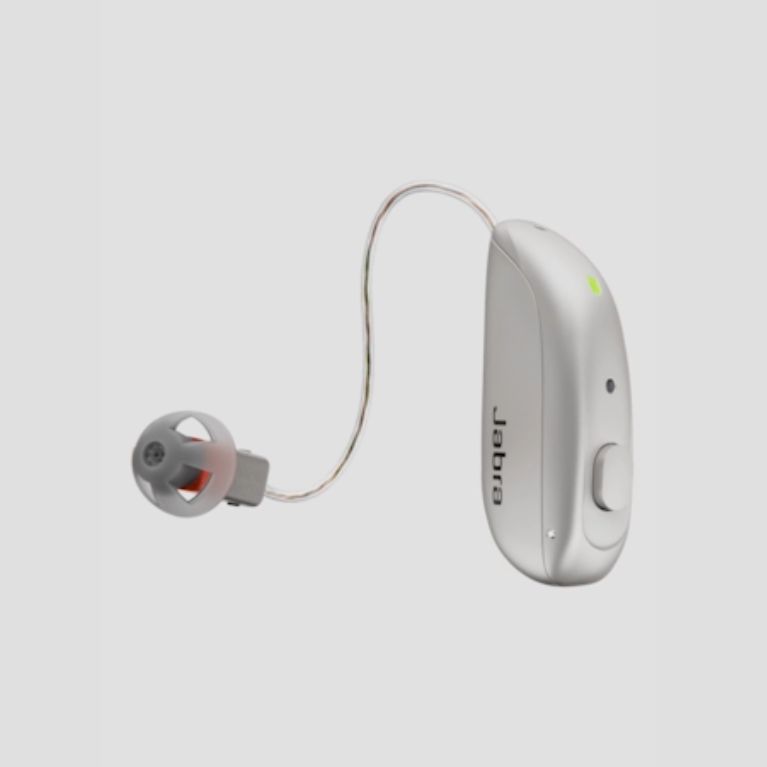
|
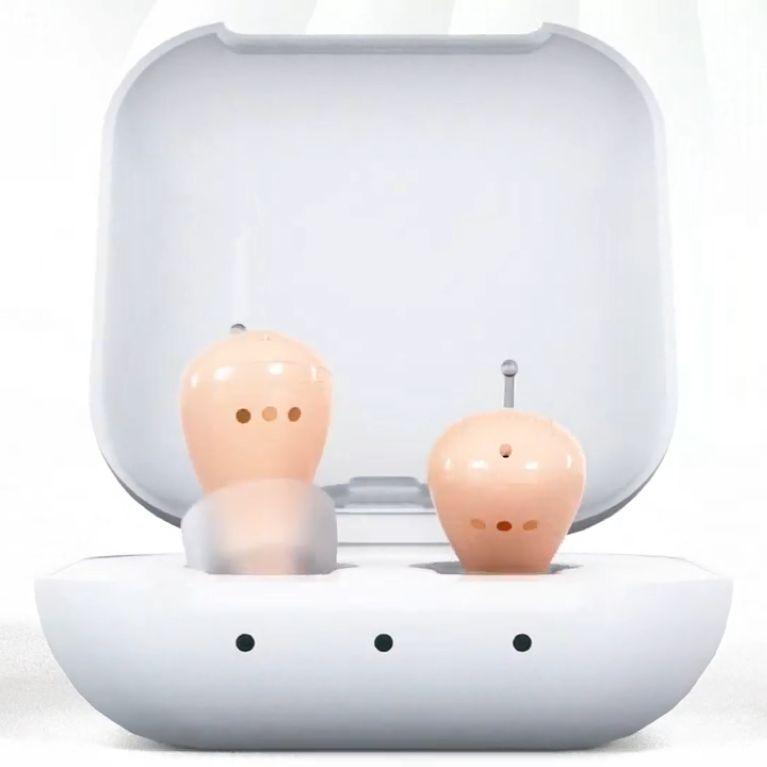
|
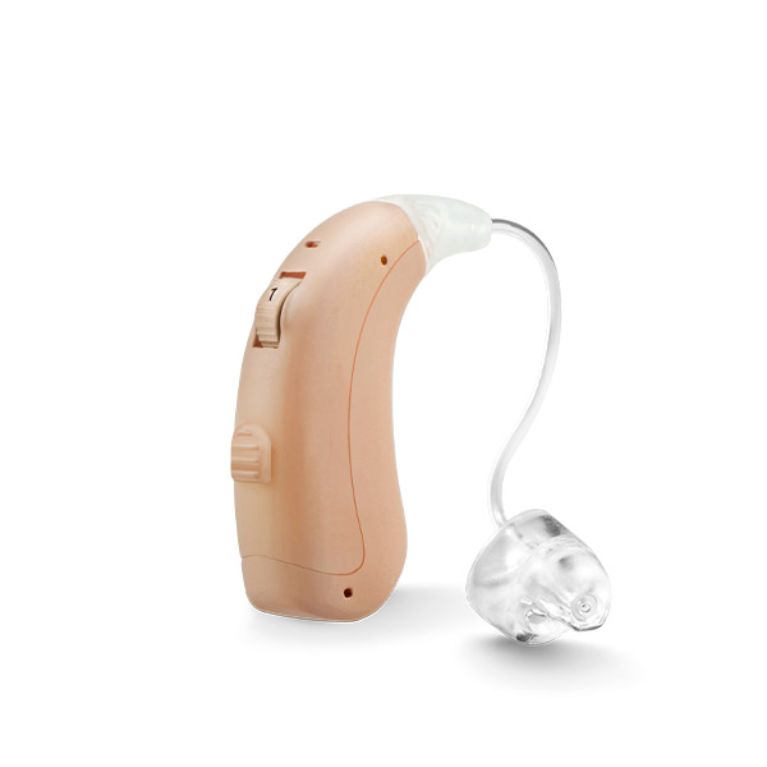
|
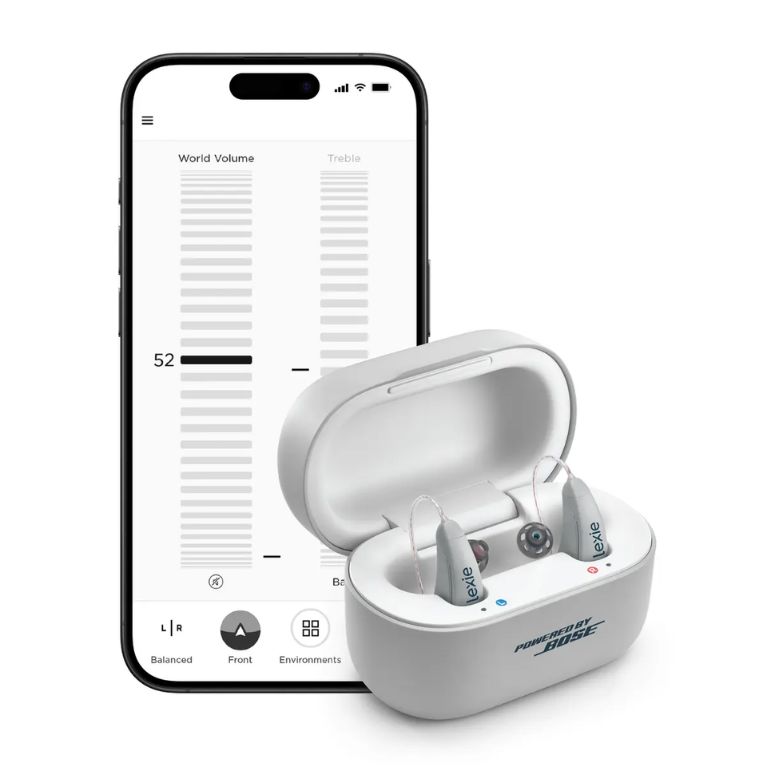
|
|
| Eargo 7 | Jabra Enhance™ Select 500 | Audien Atom 2 | MDHearing VOLT | Lexie B2 Plus | |
| Rating | |||||
| Price | $2,950 | $1,795/$1,995 | $189 | $397 | $999 |
| Type (OTC or prescription) | OTC | OTC | OTC | OTC | OTC |
| Style | CIC | RIC | ITE | BTE | RIC |
| Battery type | Rechargeable | Rechargeable | Rechargeable | Rechargeable | Rechargeable |
FAQs
Is Eargo a hearing aid or an amplifier?
Eargo is an FDA-approved, over-the-counter hearing aid designed to help people with mild to moderate hearing loss. Unlike amplifiers that boost all sounds, Eargo devices include features like noise reduction and sound adjustment to enhance speech clarity.
Does Medicare pay for Eargo hearing aids?
No, Medicare does not cover the cost of Eargo hearing aids, though some Medicare Advantage plans may offer partial coverage or discounts. It’s important to check with your specific plan for details.
Do Eargo hearing aids work with Bluetooth?
Eargo hearing aids do not support Bluetooth audio streaming. However, the device uses Bluetooth to connect to the Eargo app, so users can adjust settings like volume and program modes through their smartphones.

Lauren Sherman
Fortune Recommends Writer
About Author
Our experts
Dr. Heidi Moawad
Dr. Heidi Moawad is a neurologist and teaches at Case Western Reserve University School of Medicine in Cleveland, Ohio. She serves on the editorial board of Neurology Clinical Practice and is a reviewer for Neurology.
Krista Manning
Krista Manning is an accomplished medical copy editor and fact-checker who stands out in the pharmaceutical, health, and wellness domains. With a meticulous eye for detail and a command of medical language, Krista ensures the accuracy and clarity of content. Beyond her professional expertise, Krista is an advocate for mental health awareness. Recognizing the crucial intersection of psychological and physical well-being, she actively contributes to projects that promote mental health awareness within the healthcare narrative. Krista’s commitment extends beyond the pages she edits, emphasizing the holistic nature of health communication.
Sources
- Mahboubi, H., Lin, H. W., & Bhattacharyya, N. (2018). Prevalence, Characteristics, and Treatment Patterns of Hearing Difficulty in the United States. JAMA otolaryngology– head & neck surgery, 144(1), 65–70. https://doi.org/10.1001/jamaoto.2017.2223
- OTC Hearing Aids: What You Should Know. FDA. https://www.fda.gov/medical-devices/hearing-aids/otc-hearing-aids-what-you-should-know#OTCHearingAids
- Sindi A, et al. The Hearing Aid Effect in the 2020s: Where Do We Stand? April 29, 2023. https://www.cureus.com/articles/152262-the-hearing-aid-effect-in-the-2020s-where-do-we-stand#!/
- Hearing Aids Market Size, Share & Trends Analysis Report By Product Type (BTE, Canal Hearing Aids), By Technology (Digital, Analog), By Sales Channel, By Region, And Segment Forecasts, 2024 – 2030. Grand View Research. https://www.grandviewresearch.com/industry-analysis/hearing-aids-market#
- New Research Finds 1 in 3 Would Try and Hide Hearing Aids if They Needed Them. RNI:D. Sept. 4, 2024. https://rnid.org.uk/2024/09/social-stigma-around-hearing-aids/
- Validating a Self-fitting Hearing Aid. National Library of Medicine Clinical Trials. Updated April 25, 2023. https://www.clinicaltrials.gov/study/NCT05246904
- Mitchel, B. What Does ‘IPX7 Waterproof’ Mean? | Understanding The IP Code. Focus. Jan. 6, 2021. https://wavelength.focuscamera.com/what-does-ipx7-waterproof-mean-understanding-the-ip-code/
